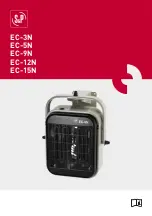
30
system diagnostics
your water heater is equipped with an ignition module that
incorporates a diagnostic system to assist in troubleshooting the
appliance. The indicator codes on the ignition module are as follows:
taBle 11:
1 FLASh
System lockout (retries or cycles exceeded)
2 FLASheS
Pressure switch stuck close
3 FLASheS
Pressure switch stuck open
4 FLASheS
Open on high temperature limit switch (eco)
6 FLASheS
115 volt AC power reversed (check polarity)
7 FLASheS
Low flame sense signal (make sure flame sensor is in
burner flame)
8 FLASheS
Check ignitor
continuous flash -> continuous flame sensed > 5 seconds without
gas valve
continuous on -> internal control failure - replace ignition control
module.
Use this diagnostic system in conjunction with the “OPerATIONAL
CheCkLIST” and the “SeQUeNCe OF OPerATION” to
troubleshoot the appliance.
ignition module system
Before calling your service agent, the following checklist should
be examined to eliminate obvious problems from those requiring
replacement or servicing.
• Check that “main manual gas shutoff valve” is fully open and
that gas service has not been interrupted.
• Check that after following the appliance OPerATING
INSTrUCTIONS, the “Top knob” of the appliance gas valve
is in “ON” position.
• Check electrical supply to the appliance for possible blown
(or tripped) fusing or power interruption. Also check the 3
amp fuse on the front of the digital thermostat (Fig. 2).
• Is the water temperature in tank below the thermostat dial
setting on the appliance thermostat (calling for heat)?
• It is possible that the high limit (e.C.O.) has functioned to
shut off the appliance. See high Limit page 7 - high Limit
Switch for reset procedure. Contact your service agent if limit
continues to function to shut off appliance.
for your information
serVice
The installer may be able to observe and correct certain problems
which may arise when the unit is put into operation. hOWeVer,
it is recommended that only qualified service agents, using
appropriate test equipment, be allowed to service the heater.
As preliminary step, check wiring against diagram, check for
grounded, broken or loose wires. Check all wire ends to be sure
that they are making good contact.
electrical serVicing
LABeL ALL WIreS PrIOr TO DISCONNeCTION WheN
SerVICING CONTrOLS. WIrING errOrS CAN CAUSe
IMPrOPer AND DANGerOUS OPerATION.
VerIFy PrOPer OPerATION AFTer SerVICING.
start up conditions
smoke/odor
It is not uncommon to experience a small amount of smoke and
odor during the initial start-up. This is due to burning off of oil
from metal parts, and will disappear in a short while.
strange sounds
Possible noises due to expansion and contraction of some metal
parts during periods of heat-up and cool-down do not necessarily
represent harmful or dangerous conditions.
Condensation causes sizzling and popping within the burner area
during heating and cooling periods and should be considered
normal. See “Condensation” in this manual.
condensation
Whenever the water heater is filled with cold water, some
condensate will form while the burner is on. A water heater may
appear to be leaking when in fact the water is condensation.
This usually happens when:
a. A new water heater is filled with cold water for the first time.
b. Burning gas produces water vapor in water heaters,
particularly high efficiency models where flue temperatures
are lower.
c. Large amounts of hot water are used in a short time and the
refill water in the tank is very cold.
Moisture from the products of combustion condense on the cooler
tank surfaces and form drops of water which may fall onto the
burner or other hot surfaces to produce a “sizzling” or “frying” noise.
operational conditions
smelly water
The water heater has at least one anode rod for corrosion
protection of the tank. Certain water conditions will cause a
reaction between this rod and the water. The most common
complaint associated with the anode rod is one of a “rotten egg
smell” in the hot water. The smell is a result of four factors which
must all be present for the odor to develop:
a. A concentration of sulfate in the supply water.
b. Little or no dissolved oxygen in the water.
c. A sulfate reducing bacteria which has accumulated
within the water heater (this harmless bacteria is
nontoxic to humans).
d. An excess of active hydrogen in the tank. This is caused
by the corrosion protective action of the anode.
Smelly water may be eliminated or reduced in some water heater
models by replacing the anode(s) with one of less active material,
and then chlorinating the water heater tank and all water lines.
Contact the local water heater supplier or service agency for
Summary of Contents for (A)BCG3 85T500-8N
Page 51: ...notes ...
















































